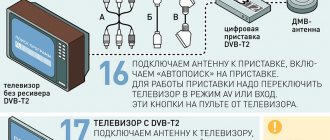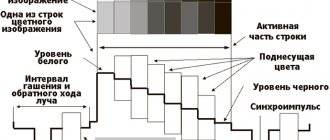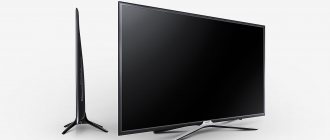Do you know how modern cable television differs from the old, analog, “from the 90s”? Is it really possible to transmit hundreds of channels via cable? How does the signal get to your apartment? “City News” and cable TV operator “Interra” answer these and other questions. They also tell you why cable TV in Revda can (and should) be cheap.
Alexey Tikhonov, network installer, cable technician. Works since 2009 in . Photo// Ksenia Kakshina, Revda-info.ru
What exactly is “digital cable television”?
Cable TV became ubiquitous in the 90s. Operators worked on networks built on coaxial copper cable, which ran sequentially from house to house. Accordingly, the signal went in analog mode, from house to house, without encryption. And through the copper endings it got to the subscribers’ TVs. All this had a bad effect on quality, which extremely irritated subscribers.
Modern cable television is built on digital data transmission. Yes, just like any digital TV. The signal is delivered to homes using digital encryption. Each house is equipped with equipment that decrypts the signal and delivers it to subscribers’ apartments.
To put it very simply, digital cable TV is one in which both sound and picture are encrypted in binary code. This allows you to maintain the quality in its original form. It does not change during encryption and decryption.
How to receive digital TV
Reception of a digital signal is possible if the TV has a built-in receiver that supports the following formats:
- DVB-T2 – for receiving over-the-air signals.
- DVB-C, DVB-C2 – for connecting to cable television.
- DVB-S, DVB-S2 – for reception via satellite dish.
Another way to get a high-quality digital signal is to connect to the Internet. To do this, the TV must have a Wi-Fi or LAN input and support Smart mode.
If the TV meets the listed parameters, the only thing left is the settings. You need to set the signal source - cable, antenna or Wi Fi (LAN). Then switch to searching for digital channels and wait for the result. Otherwise, you will have to purchase the appropriate attachment. Most likely, you can use an old one as an antenna, which picked up an analog signal. In rare exceptions, you have to tune it exactly to the television center or buy a new one. Especially for such cases, we have prepared an article about which antenna to choose for digital TV.
How can I choose the channels I need?
Focusing on the interests of your family, of course. Have children? We need cartoons. Elderly? TV programs about health, series. Men? Sports, fishing, hunting. The right operator has a call center (you've probably received a call at least once asking how often you watch TV and what exactly). Based on the requests of subscribers, they compile a list of channels. With TV series and films, for example, or educational ones. But you, of course, get the entire available list - and decide for yourself what you will watch.
Satellite TV: how much does it cost and who is it suitable for?
Satellite television has a different broadcasting principle. In this case, the signal comes directly from the satellite, bypassing the TV tower, to a special satellite dish (the same “dish”). The “delivery” of the signal from the satellite to the dish is carried out by the satellite TV operator, who charges a fee for its services.
On the one hand, the benefit seems rather dubious:
- Satellite TV requires special equipment . A set for receiving satellite television costs more than 3.5 thousand rubles, although this is a one-time purchase. It includes the “dish” itself, which also requires external installation, and a set-top box that will transmit the antenna signal to the TV.
- Satellite TV is provided at tariffs . When purchasing a dish, you must connect at least one channel package, for which a subscription fee is charged. Therefore, not a single satellite operator has a basic package of only twenty federal channels, otherwise they would not have the right to take money from you.
- Satellite TV requires space to receive the signal . In a densely populated area with developed infrastructure, where high-rise buildings and other buildings, wires, trees, poles, as well as various electromagnetic fields may interfere with the antenna’s signal reception, it may arrive weakly or with interference. For reliable reception there should be nothing between the antenna and the sky.
Satellite TV sets
Cost - from 1200 rubles.
depending on the configuration. Buy
On the other hand, the disadvantages of satellite TV, when looked at in a certain way, turn into advantages:
- Satellite TV broadcasts directly from a satellite . This means that the signal does not depend on how close your house is to the TV tower - you can catch a “satellite” even in the taiga, if only you had an antenna. The coverage of satellite TV is thus greater than that of digital, and much greater than that of cable, which is discussed below. The main thing is that there is no physical interference in the signal path.
- Satellite TV offers cheap rates . In fact, prices from satellite TV operators are quite low, and the conditions are favorable. For a basic package of 20 state and, for example, 160 paid channels, you will be charged about 150 rubles per month - and some operators have special “economical” packages for 50-60 rubles. If desired, you can add additional ones to the basic package.
- Satellite TV allows you to watch foreign channels. After all, TV channels from different countries can broadcast via a common satellite. If, for example, you are a passionate sports fan, and the matches of your favorite team are not broadcast in Russia, an additional package of foreign sports channels will help you. This option is only available from a satellite.
What conclusion can be drawn from this? Satellite TV is an ideal option for those who live far from a TV tower (for example, in a regional village) and for summer residents to whom terrestrial TV “does not reach.” And also for residents of the upper floors of high-rise buildings in cities - they can afford to install a dish and watch more channels for a small fee, and not be content with the “Culture” channel and the “Fashionable Sentence” program. And also for those who don’t like it when the state dictates what to watch.
What channels will be available?
Also a common question. So far, 2 multiplexes have been launched everywhere in Russia. Here is the list of channels:
The third multiplex is currently being tested.
I really hope that the main difference between analogue TV and digital has been learned - the new television is much better than the previous one in all respects and especially in quality, and it’s also free. It's not that expensive to go digital, so my opinion is that it's a must. We end here, you can leave all questions and your opinions in the comments below. See you soon!
How to find out what kind of TV your TV shows: digital or analogue
Until October 14, 2021, analogue broadcasting will be stopped in those regions where it is still ongoing. Therefore, TV viewers want to understand what kind of TV they watch.
This question is relevant for residents of regions where both types of broadcasting are carried out. We are talking about the following territories:
- St. Petersburg and Leningrad region;
- Murmansk region;
- Vologda region;
- Pskov region;
- Belgorod region;
- Kaluga region;
- Kursk region;
- Astrakhan region;
- Volgograd region;
- Orenburg region;
- Saratov region;
- Chelyabinsk region;
- Altai Republic;
- Republic of Karelia;
- Republic of Crimea;
- Republic of Bashkortostan;
- Transbaikal region.
Residents of these regions have several ways to find out what kind of television is working in their home.
- Check if there is a letter “A” next to the name of the TV channel. It is used to designate analog channels; accordingly, if it is present, the TV shows ATV.
- If the TV is old and works without a receiver, it means analog television is connected.
- If the TV can receive an encoded signal without a receiver, you can determine the type of broadcast using the antenna plug. You need to take it out and hold it at a distance of half a centimeter from the socket. If the picture quality deteriorates, but the TV continues to show, it means that analog TV is being received. If the video disappears completely, DTV is connected.
- You can open the “Signal Source” section in the TV menu.
- Digital television is better than analogue in terms of picture quality, and if the picture is bright and very clear, it is most likely DTV.
It’s worth figuring out in advance what signal the TV receives so that you don’t end up without TV in the fall.
Important! Citizens who live in other regions and are connected to terrestrial TV definitely watch DTV, since they no longer have ATV.
How to determine the broadcast type
It is impossible to tell by eye, just by the type of wire, whether cable television is digital. The ideal option to obtain accurate information about the type of broadcast is to call the provider . But it happens that the new home owner simply does not know whose services the previous owners of the apartment used.
In this case, you can determine whether the wire is digital or analog using any TV. The cable is inserted into the antenna socket. After this, an automatic channel search is performed. An old analog TV on digital cable will not find anything at all. But the modern model will show everything clearly and in detail. That is, it will display a summary table indicating the number of digital and analog channels.
But you still shouldn’t abandon the idea of calling your provider. Firstly, you will still have to conclude a new agreement. Secondly, it can broadcast in a hybrid scheme, offering a digital stream of channels and requiring an Internet connection to authorize the user and decode the broadcast.
Which signal is better
It should be recognized that, despite many improvements implemented in the field of analog representation of information, this method of broadcasting has retained its shortcomings. These include distortion during transmission and noise during playback.
Also, the need to convert an analog signal to a digital one is caused by the unsuitability of the existing recording method for storing information in semiconductor memory.
Unfortunately, existing TV has virtually no obvious advantages over digital, excluding the possibility of receiving a signal with a regular TV antenna and sharing it between TVs.
Summary
The main difference between digital TV and cable TV is that the former can use two types of signals. The second type has many varieties and uses a variety of transmission media, and also provides higher quality compared to cable.
Post Views: 1,172
More from Video surveillance
620
Types and purpose of surveillance cameras
Published 03/22/2021 Vladimir Basmanov 0
CCTV cameras are a convenient tool for increasing the security of your home. They may differ in size, appearance and technical characteristics. To …
204
Video surveillance in an apartment: where to install and what equipment to choose
Published 03/19/2021 Vladimir Basmanov 0
Whether you live in a studio apartment or a six-bedroom apartment, video surveillance systems help protect you. ...
235
TV antenna sensitivity
There is no universal recipe for choosing the ideal antenna, but there are mandatory requirements that must be met in order for it to receive analog and digital signals. As the distance from the broadcast object increases, these requirements increase. In particular, to the sensitivity of the receiver - its ability to pick up weak-intensity television signals. Often they are the cause of a blurry image. This problem is solved with the help of an amplifier, which significantly increases the sensitivity of the antenna and removes the question: how to connect it to digital television? The same TV, and the same antenna, only an over-the-air digital tuner will appear near the TV.











